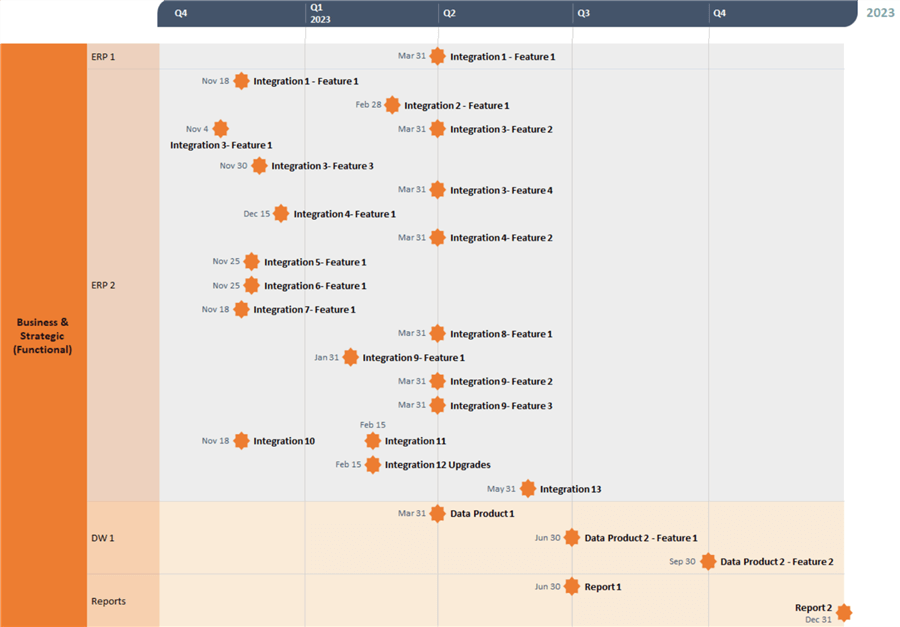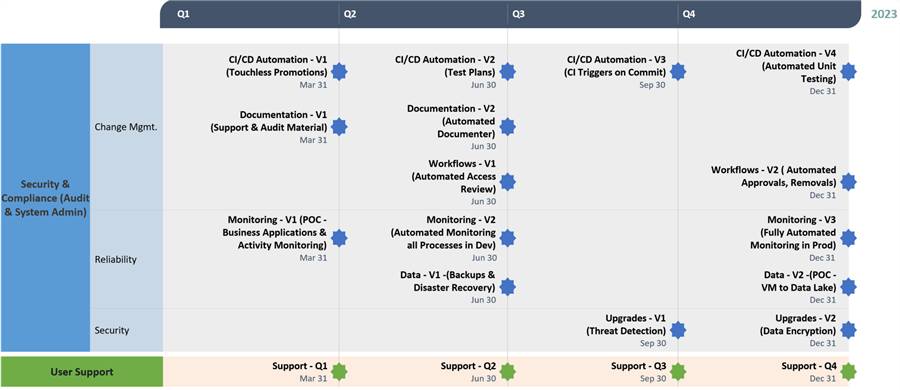By: Ron L'Esteve | Updated: 2023-01-09 | Comments | Related: > Cloud Strategy
Problem
Senior IT Leaders within large organizations are oftentimes held accountable for setting strategic technology roadmaps on an annual basis which must be further dissected into tactical delivery plans. While these roadmaps are typically organized, socialized, and finalized close to the beginning of a new fiscal year, they continue to mature and evolve over multiple iterations and updates through the year as deliverables are developed and deployed. This article intends to cover a few tips for creating a technology roadmap for your organization by identifying requirements, priorities, stakeholders, and plans.
Solution
When embarking on the journey to begin creating a technology roadmap, it is important to account for the strategic objectives of the business stakeholders to achieve the mission of developing and supporting IT solutions to achieve business goals. For example, as part of a business' acquisition-based growth model, they might need to build out an integration for a newly acquired ERP system by a certain go-live date. This sort of initiative would be a prime candidate for a spot on the Technology Roadmap after further discussing scope and timeframes with the key stakeholders. Similarly, there may be a multitude of other integrations and strategic business projects that are competing for a spot on your Technology Roadmap for the upcoming fiscal year. While these initiatives are critical for the success and growth of the business, they might not always fulfill the goals and objectives of the larger IT department.
Although the IT teams are dedicated to design, develop, deliver, and support these various business objectives, they also have planned initiatives of their own. This can include security upgrades, compliance readiness, reliability enhancements, and change management innovations. All these various planned technology initiatives for the upcoming year coupled with in-complete prior year initiatives can quickly fill up your entire technology roadmap. When this happens, it will warrant the discussion of priority and headcount availability of internal teams to deliver on time and within budget. In the subsequent sections of this article, we will take a closer look at a sample annual Technology Roadmap including both business and technology initiatives, and take a deeper dive into how we can set, refine, and deliver on the committed initiatives on a technology roadmap.
Preparing the Strategic Technology Roadmap
In their 2017 article, "Building an integrated technology road map to drive successful innovation" McKinsey & Company accurately states that "An effective technology roadmap links corporate strategy with portfolio management and project execution." A well-defined strategic roadmap is the foundation and cornerstone of an organization's top-down vision which must effectively result in clear bottom-up project deliverables and realities.
An annual technology roadmap is long enough in duration to achieve the objective of setting an innovation-driven vision that goes beyond just a few iterations of existing products or services. Defining a roadmap with initiatives that stretch across twelve months or beyond empowers stakeholders and development teams to think through innovative yet realizable objectives that stretch beyond just short-term enhancements. These visionary objectives may start as a proof of concept or minimum viable product and then scale to grow the organization towards cutting-edge solutions that solve legacy problems, optimize cost, enhance performance, improve productivity, and much more.
Challenges
Setting long-term roadmaps also has its challenges. McKinsey's article discusses a few interesting potential challenges which are relevant in the discussion of creating a long-term technology roadmap. The 'moving-target dilemma', addresses how we might need to deal with market changes and long-term roadmap plans that may evolve in the future. By viewing a technology roadmap as an evolving resource, we can iterate through potential changes at various milestones to ensure that we effectively manage this potential dilemma. The 'resource-focus dilemma' is another challenge that is bound to surface while preparing technology roadmaps. Both innovative technology and business project-based initiatives require various resources including headcount, funding, and more.
By level setting the potential requirements and risks of defined roadmap items ahead of time, this may help with uncovering possible constraints and can contribute to re-evaluating and re-prioritizing proposed long-term roadmap plans. Finally, the 'evolution-revolution dilemma' is one to consider ahead of time to support defining the optimal balance between iterative evolution-based initiatives versus innovative revolution-based initiatives on your roadmap. While the IT team may want to consider a new revolutionary alerting and monitoring product to integrate and implement within the IT organization, they may also want to evolve an existing process that for example heavily relies on a server for data storage into a cloud-based data lake storage platform. A cost-benefit analysis of these evolution vs. revolution initiatives would help with evaluating and prioritizing these technology roadmap initiatives. When sharing and presenting your roadmap to the relevant stakeholders, remember to talk about the strategic value of the proposed initiatives without focusing on the technical details too much but still having those relevant details ready when requested.
Business Initiatives
The IT Department may receive requirement specifications from various business stakeholders that need to be developed by a certain timeframe to meet the organization's strategic business objectives and growth plans. While IT may sometimes have low-touch involvement in these business and functional requirements, they might also have high-touch involvement if there is a heavy technology component to the deliverable requiring significant resource and time involvement. As an example, the figure below shows a sample business-focused technology roadmap for multiple systems and themes which would significantly utilize IT resources throughout the year. The Business stakeholders will be the primary audience of this roadmap and it may be to be presented to them along with other stakeholders including technology, finance, and executive leadership for reviews and re-assessments. Having a well-defined roadmap like this ahead of time helps with better planning for resource availability, deliverable timeframes, prioritization assessments, organizational goal level-setting, and iterative refinements to the roadmap. Having a prior year rolling roadmap also helps with tracking initiatives that are close to being completed by year end along with identifying ones that may roll over into the new year.

Technology Initiatives
Like the business and strategic roadmap items, you will also need to identify the technology-related initiatives that support growth, innovation, security, compliance, and more. The figure below captures sample themes that can be a part of this technology-centric section of your overall technology roadmap. For example, your organization can plan to get better with Change Management workflows through upgrades and innovations in CI/CD automation along with better documentation. From a reliability perspective, there may be opportunities for similar upgrades and new technologies around monitoring and data availability. Finally, from a security perspective, there may be opportunities for further functionality. It also helps to assign an epic-level title (e.g.: Automated Documenter) to your high-level theme title (e.g.: Change Management). This will help when it is time to build your delivery plan which includes your overall backlog and granular task assignments to achieve the tactical goals to iteratively achieve the strategic vision. You will also want to plan for User Support since that may potentially cause resource constraints to plans if they are not accurately accounted for.

Planning to Deliver the Roadmap Initiatives
As you begin to finalize and obtain approvals for the first iteration of your technology roadmap for the new year, you will need to work with your teams of developers to begin tactically planning to deliver the planned goals. Both the Delivery Team and Delivery Plan are critical as your roadmap's high-level plans begin to translate into actionable tasks. At this point, it would be wise to begin meeting with your scrum team comprised of your Scrum Master, Product Owner, Developers, Architects, Business Analysts, System Administrators, and others that are selected to deliver and support your organization's technology roadmap.
Set iterative discussions with your Agile Scrum teams to determine priorities, actionable development tasks, testing plans, and deployment schedules as part of the Delivery Plan. This stage will uncover the granularities of the high-level plans by translating them into tasks in a backlog. These backlog items can then be assigned to the delivery team members to take responsibility and action on. It is this delivery team coupled with actionable delivery plans that will drive these technology roadmap initiatives to successful completion. Remember to level-set with stakeholders to promote realistic expectations and timelines, while also accounting for delays resulting from turnover, vacations, sickness, etc. Supporting your delivery team, having realistic expectations, and mitigating risks effectively will yield dividends in the long road to delivering the planned initiatives successfully on time and within budget. In addition to scheduling recurring checkpoints with your delivery team, it would also be beneficial to have frequent check-ins with your business and executive stakeholders to provide a status of each high-level initiative on your technology roadmap on a recurring basis (e.g.: Monthly).
Summary
One of the many responsibilities of an IT leader within an organization is to define a strategic plan and tactical annual Global IT roadmap and guide the business toward an IT strategy that supports the overall digitization of the business by delivering multiple Cloud, On-Premises, and Hybrid platform-based Data, Analytics, Integrations, and Infrastructure solutions. This article aims to help with explaining the process of creating a technology roadmap along with iteratively refining it as delivery plans are defined. The roadmap must clearly define and prioritize multiple technology, business, and support-related initiatives while accounting for the potential challenges and constraints. And remember that your technology roadmap can evolve over time based on updates and changes within your organization. By setting realistic expectations with your leadership and development teams, you will get the support needed to deliver your roadmap and be well-positioned for success and advancement in your role as your organization also continues its successful growth trajectory.
Next Steps
- Read more about How to Create a Product Backlog? | 5 Quick Tips to Create Effective Product Backlog (premieragile.com)
- Read more about Building an integrated technology road map to drive successful innovation | McKinsey
- Read more about 6 steps to creating your technology roadmap | BDC.ca
- Read more about How to Build a Technology Roadmap | Steps and Examples (productplan.com)
- For a neat and easy to use Powerpoint add-in to create your IT Roadmap and timelines, explore Office Timeline Add-in – Pro+ Edition
About the author
 Ron L'Esteve is a trusted information technology thought leader and professional Author residing in Illinois. He brings over 20 years of IT experience and is well-known for his impactful books and article publications on Data & AI Architecture, Engineering, and Cloud Leadership. Ron completed his Masterís in Business Administration and Finance from Loyola University in Chicago. Ron brings deep tec
Ron L'Esteve is a trusted information technology thought leader and professional Author residing in Illinois. He brings over 20 years of IT experience and is well-known for his impactful books and article publications on Data & AI Architecture, Engineering, and Cloud Leadership. Ron completed his Masterís in Business Administration and Finance from Loyola University in Chicago. Ron brings deep tecThis author pledges the content of this article is based on professional experience and not AI generated.
View all my tips
Article Last Updated: 2023-01-09






